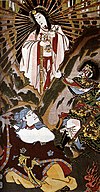Futako Shrine
You can help expand this article with text translated from the corresponding article in Japanese. (March 2016) Click [show] for important translation instructions.
- Machine translation, like DeepL or Google Translate, is a useful starting point for translations, but translators must revise errors as necessary and confirm that the translation is accurate, rather than simply copy-pasting machine-translated text into the English Wikipedia.
- Consider adding a topic to this template: there are already 1,107 articles in the main category, and specifying
|topic=will aid in categorization. - Do not translate text that appears unreliable or low-quality. If possible, verify the text with references provided in the foreign-language article.
- You must provide copyright attribution in the edit summary accompanying your translation by providing an interlanguage link to the source of your translation. A model attribution edit summary is
Content in this edit is translated from the existing Japanese Wikipedia article at [[:ja:二子神社]]; see its history for attribution. - You may also add the template
{{Translated|ja|二子神社}}to the talk page. - For more guidance, see Wikipedia:Translation.
Futako shrine (二子神社, Futako jinja), located in Takatsu-ku, Kawasaki, is a Shinto shrine in Kanagawa prefecture, Japan. It was established in 1641 and was called "Shinmeisha". It was renamed "Futako Shrine" in the Meiji Era, after the area in which it is located.
Features
It is known for the "Kanoko Monument" sculpture next to the shrine. The sculpture was made by the artist Tarō Okamoto, who was born locally. The sculpture is dedicated to the artist's mother, Kanoko Okamoto.
Gallery
- "Kanoko monument" by Tarō Okamoto
- Sixth column name
- Kōshin-tō
- Oyama lantern at the shrine entrance
- The outer torii
- Chōzuya (visitors' washing place)
-
 "Mukunoki", one of Kawasaki City's 50 selected trees
"Mukunoki", one of Kawasaki City's 50 selected trees
See also
References
External links
- website
- v
- t
- e
Shinto shrines
Shinto architecture | |||||||||
|---|---|---|---|---|---|---|---|---|---|
| |||||||||
Others | |||||||||||||||||||||||||
|---|---|---|---|---|---|---|---|---|---|---|---|---|---|---|---|---|---|---|---|---|---|---|---|---|---|
| |||||||||||||||||||||||||



















